

The Germani: Germanic Peoples Origins and History. Who were they?
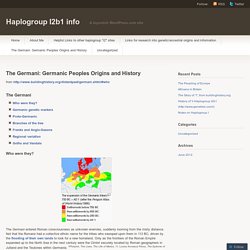
The Germani entered Roman consciousness as unknown enemies, suddenly looming from the misty distance. Not that the Romans had a collective ethnic name for the tribes who swooped upon them in 113 BC, driven by the flooding of their own lands to look for a new homeland. Only as the frontiers of the Roman Empire expanded up to the North Sea in the next century were the Cimbri securely located by Roman geographers in Jutland and the Teutones within Germania. 1Plutarch, The Lives, The Life of Marius, 11; Lucius Annaeus Florus, The Epitome of Roman History, book 1, chapter 38; Strabo, Geography, book 7, chapter 2, sections 1-2; Claudius Ptolemy, The Geography, book 2, chapter 10; Res Gestae Divi Augusti, chapter 26; Tacitus, Germania, 37; Pliny, Natural History, book 4, chapter 28.
The Germani were not a unified people. But they did have a language in common. Germanic genetic markers As we shall see, the Germani apparently sprang from a mixture of peoples. Proto-Germanic. The Celts and Celtic Society: The Difference between Germanic and Norse Tribes. The True Story of the Differences between Germanic and Norse & their Claim on the Invention of Runes by Laurie-Lee Mills The fight over the Runes being from Norse or Germans is just plain silly.
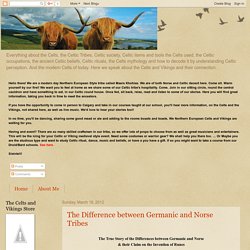
Origin and History of Celtic Speaking People. By John Arnott MacCulloch.
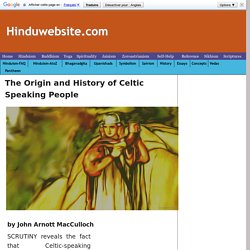
Simon James's Ancient Celts page: introduction. Celtic Art: History, Characteristics. What Were the Main Characteristics of Hallstatt Arts and Crafts?
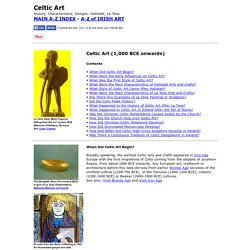
Hallstatt art from Central Europe is noted for its high quality iron tools and weaponry, along with its bronze-based manufacture of decorative items and ornamentation. But relatively few silver or Gold objects have been found from this era. Hallstatt was influenced by the militaristic Mycenean art and culture c.1650-1200 BCE which the Celts absorbed as they passed through the Black Sea area. BBC Wales - Education - Iron Age Celts.
Celtic Art: History, Characteristics. Celtic Culture: Characteristics of Visual Art, Language, Religion. Gaelic. BBC Wales - Education - Iron Age Celts. Sccfaq. Celtshistory. [Top]

Celtic Interlace Designs. In Search of Ancient Ireland . Technology. By Carmel McCaffrey and Leo Eaton ometime in the fifth millennium B.C., new technology arrived in Ireland, carried by immigrants from Europe or native Irish who had learned new skills overseas.
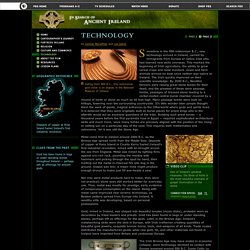
This marked the beginning of Irish agriculture, the ability to grow cereal crops and raise livestock. Grain and farm animals arrived by boat since neither was native to Ireland. The Irish quickly improved on their scientific knowledge: By 3500 B.C., Neolithic farmers were raising great stone tombs for their dead, and the greatest of these were passage tombs, passages of dressed stone leading to a corbel-roofed central burial chamber covered by a mound of earth or stone as much as 40 feet high. Many passage tombs were built on hilltops, towering over the surrounding countryside.
Metal came first to Ireland around 2400 B.C. as the Bronze Age spread north from the Middle East. Not only were metal products hard to make, they were not practical; stone axes still worked better for everyday use. Simon James's Ancient Celts page: introduction. The celts in Germany. Up until five years ago German archaeologists assumed that findings north of the river Main in the area of Hessen had to be considered as being of mixed Celtic / Germanic origin.
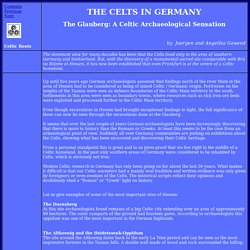
Fortresses on the heights of the Taunus were seen as defence boundaries of the Celtic Main territory to the south. Settlements in this area were seen as boundary towns, where resources such as rich iron ore beds were exploited and processed further in the Celtic Main territory. Even though excavations in Hessen had brought exceptional findings to light, the full significance of these can now be seen through the excavations done at the Glauberg.
It seems that over the last couple of years German archaeologists have been increasingly discovering that there is more to history than the Romans or Greeks. At least this seems to be the case from an arhaeological point of view. From a personal standpoint this is great and to us gives proof that we live right in the middle of a Celtic homeland. Round Houses - Celtic Houses and Homes. Historical Evidence The classical author, Diodorus Siculus, was probably quoting the earlier writer, Posidonius, when he stated: the inhabitants of Britain lived in mean dwellings made for the most part of reeds and wood ...
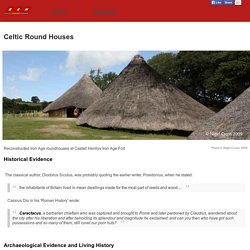
Cassius Dio in his 'Roman History' wrote: Caractacus, a barbarian chieftain who was captured and brought to Rome and later pardoned by Claudius, wandered about the city after his liberation and after beholding its splendour and magnitude he exclaimed: and can you then who have got such possessions and so many of them, still covet our poor huts? Archaeological Evidence and Living History. Celtic Life. About 650 BC the Celts introduced iron into Britain and they made the first swords.
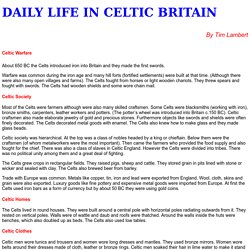
Warfare was common during the iron age and many hill forts (fortified settlements) were built at that time. (Although there were also many open villages and farms). The Celts fought from horses or light wooden chariots. They threw spears and fought with swords. The Celts had wooden shields and some wore chain mail. Most of the Celts were farmers although were also many skilled craftsmen. Celtic society was hierarchical.
The Celts grew crops in rectangular fields. Trade with Europe was common. Animal Symbolism in Celtic Mythology. <editorial date="2007"> This document is readable by you today, almost 14 years after I wrote it and more than 12 years after I put it on the web, because of open formats.
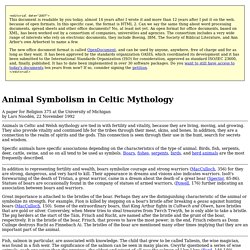
In this specific case, the format is HTML 2. Can we say the same thing about word processing documents, spread sheets and other office documents? No, at least not yet. An open format for office documents, based on XML, has been worked out by a consortium of companies, universities and agencies. Wales - Education - Iron Age Celts - Factfile. Celtic religion.